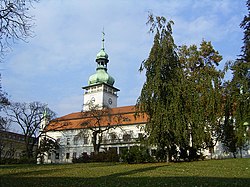Vsetín
| Vsetín | ||
|---|---|---|
| Town | ||

Vsetín Castle
|
||
|
||
| Coordinates: 49°21′N 18°00′E / 49.350°N 18.000°ECoordinates: 49°21′N 18°00′E / 49.350°N 18.000°E | ||
| Country | Czech Republic | |
| Region | Zlín | |
| Founded | 14th century | |
| Government | ||
| • Mayor | Jiří Růžička | |
| Area | ||
| • Total | 57.62 km2 (22.25 sq mi) | |
| Elevation | 342 m (1,122 ft) | |
| Population (Jan 1, 2015) | ||
| • Total | 26,504 | |
| Website | http://www.mestovsetin.cz/ | |
Vsetín (Czech pronunciation: [ˈfsɛciːn]) is a town in Zlín Region of the Czech Republic. It has around 28,500 inhabitants and lies on the Vsetínská Bečva river.
The area around Vsetín, called Vsetínsko, is spread out on the foothills of the Vsetín, Hostýn and Vizovice Highlands around the Bečva River. This area features the remains of log houses and cultural monuments of significant importance mainly in Vsetín itself.
The folk culture has been kept alive by Wallachian song and dance groups for many decades. Originally a small town, Vsetín has become an important centre of industrial, economic, cultural and sports life during the last century.
The landscape in valleys surrounding the Bečva River in Moravia-Slovakia border line was not inhabited before the Middle Ages. Man was discouraged from establishing permanent farm settlements in this region by its hilly landscape, deep forest valleys and forceful streams. Traces of settlement from primeval times in Vsetín and the surrounding area are therefore almost negligible.
The first historical records mentioning Vsetín originated in documents dated 1297–1308 and relate to the very beginning of settlement in this area. While records from 1297 mention the Vsetín region only as an area by the Bečva river, the document dated 1308 clearly describes it. In the aforesaid document a little town named Setteinz is mentioned with a church, a mill and the Freudsberg Castle and further colonization in the valley around Rokytnice is described. The Templar Knights owned Vsetín (Setteinz) at that time and rented it to Vok of Kravaře in 1308. The name of Wssetin appeared in documents from 1396 while the first entry of Vsetín Dominion in the provincial registry was implemented as late as 1505. Vsetín was successively held by other noble families, mainly of Cimburk (see the coat-of-arms in the picture), Saint Jura and Pezinek, Kunštát, Šelmberk, followed by nobility of Pernštejn, and others.
The process of colonization in the 13th and 14th centuries created the structure of the settlement in the area, followed by the "clearing" colonization from 16th century which led to the expansion of farm land at the expense of forests. During the same period, goat dairy-farming spread out from the south, along the Carpathian mountains, as the Vlach (Romanian) migration reached its peak. Though the Vlachs eventually lost their language, being linguistically assimilated, this migration contributed to the specific traditional culture and the establishment of the historic name of the region, "Wallachia" - see Moravian Wallachia.
...
Wikipedia


